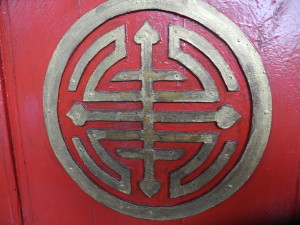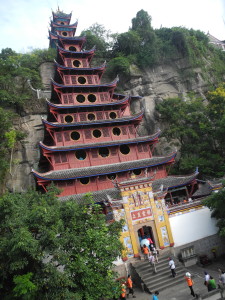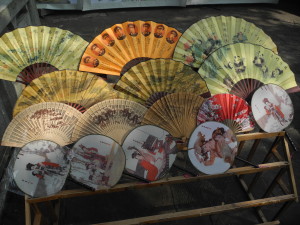Sixth in a Series:

A Chinese symbol inside the Red Pagoda — if you rub it, it’s said to bring good fortune. Photo by Clark Norton.
Like all rivers, China’s Yangtze is constantly changing, though in this case humans have produced the most profound recent changes rather than nature.
The huge Three Gorges Dam project has resulted in the water level rising more than 100 to 300 feet, depending on the location and the season, along a particularly scenic stretch of the river known as the Three Gorges. The gorges, while not as dramatically steep as the pre-dam versions, are still scenic and still well worth seeing, as my wife, Catharine, and I discovered on a recent Yangtze cruise with Victoria Cruises.
The rising waters have even opened up new scenery to explore: one excursion from our ship, the Victoria Katarina, took us on a ferry ride down the Shennong Stream, a Yangtze tributary also featuring a steep, narrow gorge, which previously was not navigable by anything bigger than a sampan.
But the human toll has been greater.
Since 2003, some 1.4 million Chinese have been displaced, their villages flooded. Many have moved to established cities like Shanghai or Chongqing — adding to their already swollen populations of 22 and 33 million populations, respectively — while others have moved to so-called relocation cities, some within close proximity to their former villages.
ShiBaoZhai is one such city, which we visited on the third and last full day of our cruise.
While the ancient village of ShiBaoZhai is now buried by water, the priceless cultural treasure there — the Red Pagoda — was saved from the flood waters by being hoisted up on a new foundation. The residents of the village once lived around and below the pagoda; those who stayed now live in a modern town above it.
Crossing the Drunken Bridge
To reach the Red Pagoda, you have to cross the “Drunken Bridge,” and shortly after you step out on it you realize how it got its name. It’s a suspension bridge made of wooden slats that starts swaying wildly when crowded, which it almost always is when cruise ships are in port.
Our guide had warned us not to use the railings on either side, or risk getting pinched fingers caught between the railings and the posts. I followed her advice to stay in the middle for about 30 seconds, but after nearly toppling over a few feet onto the bridge, I decided to risk getting pinched rather than taking a sure tumble.
The bridge seemed to go on forever, but I managed to make it across with neither pinched fingers or an embarrassing fall. Then came the mob scene to get into the pagoda itself.
With three cruise ships in port, the crush of people made the walk to the top of the ancient pagoda slow and claustrophobic, but I made it all the way to “heaven,” the tiny platform at the peak that only a few visitors could occupy at one time, and that involved climbing a steep ladder and hoisting oneself up rather precariously at the end.
The views were panoramic, but by this time the crowds had thinned out considerably and all those who reached “heaven” felt a certain unheavenly smug satisfaction in their feat. Our guide, for one, demurred.
More Upsides Than Downsides
There were a few downsides to the cruise. Considering the trials of crossing the Drunken Bridge and cramming oneself into and up the Red Pagoda, the staff could have done a better job of offering an advisory to the passengers, some of whom were quite elderly and had difficulty walking, much less negotiating swaying bridges and steep, crowded stairways.
More general port information would also have been appreciated.
We also wondered why the Katarina had no canopy to provide shade on the top deck, which was completely open to the often blazing sun. And cold beer would have been nice, rather than the lukewarm beer common in China.
But overall, the upsides to Victoria Cruises and the Katarina easily outweighed any problems.
Service was very friendly and helpful, especially in the dining rooms; the food was good; and there were two special dinners in three days: the Captain’s Welcome Dinner the first night (preceded by sparkling wine and snacks in the lounge) and the Captain’s Farewell Banquet the third night, which was served ala carte to all. (Most passengers had buffet meals the other two nights.)
American-owned, Victoria Cruise Lines does a good job of catering to a mix of Westerners (including both English and German speakers) and Chinese, with separate tour groups for each. One guided tour is included in the price each day, and there are optional separately priced tours as well.
Entertainments and Other Perks

The famous Red Pagoda of ShiBaoZhai was rescued from flooding after completion of the Three Gorges Dam. Photo by Clark Norton
Captain Gui was very ceremonious both in welcoming us and bidding us goodbye, while the evening performances — a Chinese costume show, a “cabaret” with audience participation (being participation phobic, I skipped that one), and a Chinese cultural night — were far less formal.
There were also evening movies (such as “The Last Emperor”) shown in a small theater, TVs in each cabin, and a tiny library (mostly with books in German) for added entertainment.
A local river guide lectured about the 5,000-year-old history and lore of the Yangtze — also known as China’s “Golden Highway” — and provided narration while we sailed through the Three Gorges.
Finally, I’d like to give a special nod to the ship’s doctor on our cruise, Dr. Lee, who has studied both Chinese and Western medicine and did double duty leading early morning Tai Chi and shadow boxing lessons, and who lectured on acupuncture and other traditional Chinese treatments as well. I tried acupuncture for the first time myself with Dr. Lee, and can attest that the needles don’t hurt a bit.
The placement of the needles may seem odd at first; for example, needles placed in the foot can help alleviate a headache. (It’s all based on body “meridians” — one of which runs from head to toe — that have been discovered and honed over thousands of years.)
The idea is to get the body’s Qi energy flowing freely, stopping whatever aches and pains you might have. And I have to admit, I felt pretty good afterwards.
We disembarked in Chongqing, the city of 33 million, where we came upon some ancient buildings amid chaotic construction. The air pollution was overbearing, and we were glad to fly back to Shanghai that evening, where we could find cold beer, centuries-old traditional gardens, attractive tree-lined streets to stroll in the area of the former French concession, and the pedestrian-only Nanjing Road, lined with ultra-modern shops and open-air cafes.
I highly recommend flying in and out of Shanghai when you take your Yangtze cruise. It’s a great place to ease into the culture of China and then decompress a bit at the end of your trip. China is endlessly fascinating but can be endlessly perplexing as well.
As they say on the Yangtze, just “go with the flow” and take it all in. The one thing for certain is that China is changing so fast it will be different the next time you go.
Travel Tip of the Day: There’s a current scam in Shanghai in which two or three attractive, smiling young people ask you to take their picture, chat you up for several minutes, then invite you to a “tea ceremony” that proves to be ultra-expensive. They seem so nice you can’t believe they’re scam artists. They are.
Readers: You can subscribe to my blog and get notification of every post by simply typing in your email address and clicking on the blue Subscribe button or downloading my free report, How to Ride the Coming Wave of Boomers. Thanks!













Leave a Reply